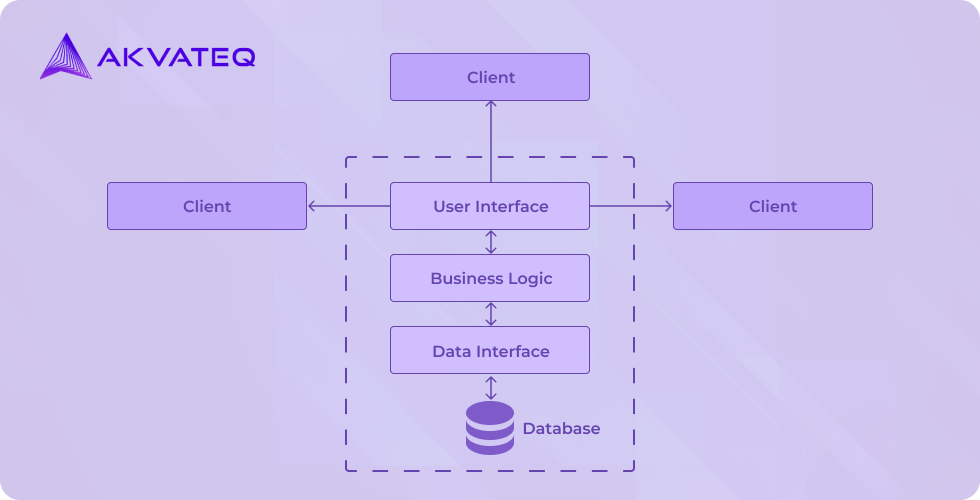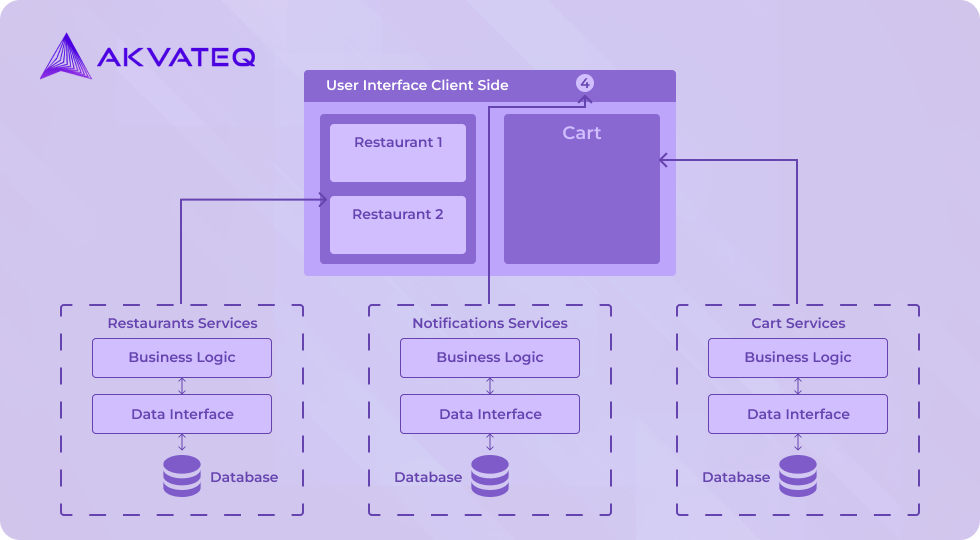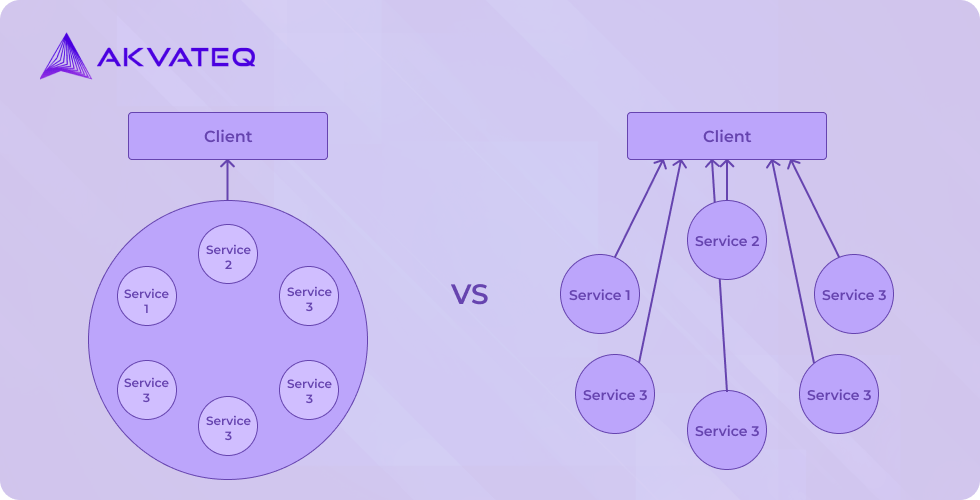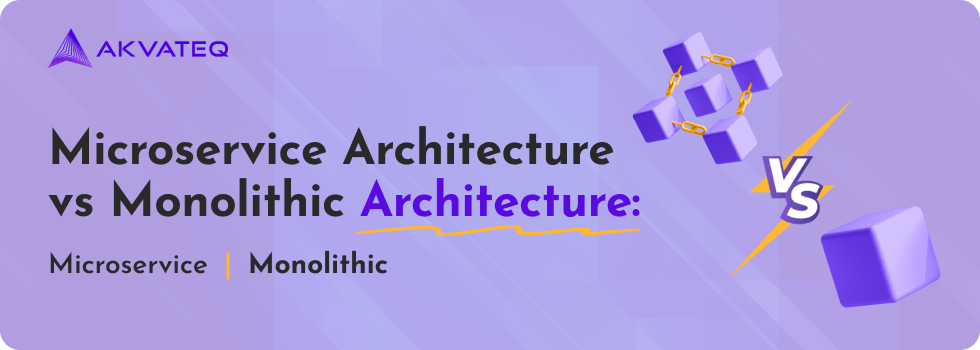In the rapidly changing world of software engineering, there’s an extensive discussion among experts about how to create applications. With the rise of cloud computing and Software as a Service (SaaS) applications, many companies have chosen to use “microservice architecture.” One primary reason for this choice is scalability, which basically means building apps that can handle a lot of users. Microservice architecture means making apps from small independent blocks that each take a specific part of the business.
Now, here’s the thing: As software developers, it’s our job to think ahead when making software or SaaS development for the future. We want to create apps that can serve millions of users. Microservices look helpful for this. They let us change one part of an app without causing problems in the other parts.
However, microservices aren’t a magical solution for everything. They have their own challenges. As we look more closely at these challenges, it becomes clear that microservices might not be the best choice for every app. Sometimes, using a more traditional way of building apps is better.
Deciding how to build applications is a big deal. The two main options are monolithic and microservice architectures. We’re going to explore both of them in detail, including what they’re good at and where they struggle. By understanding the challenges and benefits of each, we can make smarter choices when designing and creating strong applications. In this article, we’ll explore the differences, benefits, and things to think about for monolithic and microservice architectures.
Now Discuss the Microservice Architecture vs Monolithic Architecture in Details
Monolithic Architecture
One of the simplest approaches to building an application is to start with building just a single frontend, backend, and database for an application, this approach falls under the umbrella of Monolithic architecture, it’s a traditional approach to designing and building software applications. In this style of architecture, all the different components and features of an application are tightly integrated into a single, unified codebase and runtime environment,
Background
Monolithic architecture evolved in the early days of software development. It is one of the earliest and most common ways of structuring software applications, back in those days, software applications were relatively simple, Monolithic architecture emerged as a natural way to structure code since the scale and complexity of applications were limited, more importantly, computing resources were limited and expensive. Monolithic architecture made efficient use of these resources by consolidating all functionalities into a single executable. This approach reduces the overhead associated with inter-process communication and resource sharing. The lack of sophisticated tools, frameworks, and programming paradigms also contributed to the popularity of monolithic architecture. Developers often worked in environments where modularization and separation of concerns were more challenging to achieve.
For instance, here’s the typical representation of a monolithic application and its components, let’s take a closer look at each of them:

Key Components:
Applications that are built using monolithic architecture are often organized into different layers, each responsible for a specific aspect of the application’s functionality. These layers help to maintain the separation of concerns and make the application more modular. A typical monolithic application would consist of the following layers:
- User Interface (Frontend): This layer is responsible for handling user interfaces and user interactions. It includes components that manage the user experience, such as web pages, graphical user interfaces (GUIs), and APIs. The presentation layer communicates with the other layers to retrieve and display data.
- Business Logic Layer (Backend): Also known as the business logic layer, this is where the core logic of the application resides. It processes user requests, makes decisions, and performs operations based on the business rules. This layer encapsulates the application’s rules and workflows.
- Data Access Layer: The data access layer manages interactions with the database or data storage. It handles tasks like retrieving, storing, and updating data. This layer helps ensure that the application’s data operations are separate from the business logic, promoting maintainability and security.
Advantages:
Before we look at all the odds, there are some obvious benefits to building a monolithic application, Some of them are:
- Simplicity: Monolithic applications are generally simpler to design, develop, and maintain due to their single codebase. Developers have a holistic view of the entire application’s functionality, making it easier to understand and make changes.
- Ease of Development: With all components residing within the same codebase, development teams can work collaboratively on different parts of the application without dealing with complex inter-service communication.
- Debugging and Testing: Debugging and testing monolithic applications can be straightforward since the interactions between components are internal to the application. It’s easier to identify and fix issues that arise from the interactions between different parts.
- Performance: Monolithic applications can achieve good performance due to reduced inter-process communication overhead. Function calls and data sharing within a single process can be faster than communication between separate services.
- Resource Efficiency: Monolithic architecture can be efficient in terms of resource usage, as the overhead of managing multiple service instances is eliminated. This can result in efficient use of memory and computing resources.
- Deployment Simplicity: Deploying a monolithic application involves deploying a single unit, which can be easier than managing and deploying multiple microservices with complex dependencies.
- Predictable Scalability: In situations where scaling demands are moderate, monolithic applications can be scaled by replicating the entire application. This can simplify the scaling process and may be sufficient for certain use cases.
- Cost-Effective for Small Projects: For small-scale projects with limited resources and requirements, monolithic architecture can be a cost-effective choice, as it reduces the need for complex infrastructure and specialized DevOps practices.
Disadvantages:
Monolithic architecture also comes with several disadvantages, which eventually gave rise to microservices, they mainly start becoming prominent as applications grow in size and complexity. Some of the key disadvantages of monolithic architecture include:
- Scalability Challenges: Scaling a monolithic application can be a challenge. If one component of the application requires more resources, the entire application might need to be scaled, even if other components don’t require additional resources.
- Complexity: As the application grows, the complexity of the codebase can become overwhelming. Changes to one part of the application might have unintended consequences in other parts, making maintenance and debugging more challenging.
- Deployment Complexity: Deploying updates or new features can be complex and risky in a monolithic architecture. Changes to one component may require the entire application to be tested and deployed, increasing the likelihood of errors.
- Resource Utilization: Monolithic applications might not use resources efficiently. For example, if one part of the application experiences high traffic while others don’t, resources allocated to the entire application might be underutilized.
- Limited Agility: Making changes to a monolithic application can be slow and cumbersome. Development teams need to coordinate closely, and changes can’t be easily isolated or deployed independently.
- Team Collaboration: Collaboration among development teams can be challenging. Different teams working on different parts of the application might need to coordinate closely, leading to longer development cycles and potential conflicts.
- Vendor Lock-In: Since the entire application is built using a single technology stack, switching to a different technology or vendor might be difficult and costly.
Okay, we now know what monolithic architecture is, it serves as an excellent starting point for simpler projects, and the adoption of microservices becomes more appealing as applications increase in size and complexity. This decision resembles choosing between cooking a meal from scratch or opting for a diverse selection of dishes from a restaurant menu – both have their own merits, based on the context and objectives at hand, Let’s dive deeper into the newer approach.
Microservice Architecture:
Microservices architecture introduced a new way of making software applications. Instead of having one big piece, the app is split into smaller parts that work together. These smaller parts are like a team of experts, each good at one thing. They talk to each other using clear rules.
The goal of microservices is to make apps more flexible and easier to work on. It’s like building with Lego bricks. Each brick is a separate part that can be added or changed without affecting the whole structure. This way, different teams can work on different parts of the app at the same time.
Microservices are like teamwork. Imagine a sports team where each player has their role and passes the ball to others to score. This approach helps make apps better at handling lots of people and changing needs. So, from the big old way of building apps, microservices bring a fresh, modern way that makes things work better together.
Background:
In the early days of software development, a method called “monolithic architecture” was used. This packed the entire app into one big codebase. But as apps grew bigger and more complicated, problems appeared. This led to the rise of “Service-Oriented Architecture (SOA)” as another way to build apps. This new approach focused on using separate, reusable parts. However, sometimes it made things complicated because it wasn’t always flexible.
So, people looked for a simpler way to build and use these parts, and that’s when “microservices architecture” came into play. Microservices split apps into small, separate parts that can be used on their own. Each part talks to others using specific rules (APIs). A couple of things made this possible: technologies like Docker containers, which made it easy to put microservices together, and cloud platforms, which made it possible to handle lots of users.
Microservices work on ideas like “being separate” or modularity and working on their own (Autonomy). They’re like different teams in a relay race, each doing their part and producing results. This way, if one team slows down, it doesn’t affect the others. This new way of building apps fits well with modern practices like DevOps, which is like all the relay race teams working together and helping each other, or in technical terms, we call this Agility.
So, from the old “monolithic” way to the new “microservices” way, there’s been a journey in how software is built, making it more flexible, easier to manage, and ready to handle big challenges.
Now let’s understand this with an example, Suppose that we are building a food ordering application, A typical microservice architecture for this would be something like this:

As illustrated in the diagram above, we have divided the entire application into discrete, autonomous services, each responsible for managing specific data and functionalities shown within our user interface in consolidated form:
- Restaurants Service: This service is in charge of managing restaurant-related data. It handles tasks like storing information about different restaurants, their menus, and availability.
- Notifications Service: The notifications service takes care of push notifications and their management. It ensures users are informed about order updates, promotions, and other relevant information.
- Cart Service: Responsible for managing the user’s cart data, this service handles the selection of items, and quantities, and provides a seamless checkout experience.
By structuring our application in this way, we enable development teams to work on each service independently, streamlining the development process. Additionally, this architecture permits us to scale specific services based on their demand, resulting in optimized resource utilization.
Advantages of Microservice Architecture:
So now that we have broken our application into microservices, let’s analyze the benefits we have just achieved here:
- Modularity and Focus: Imagine a big puzzle. In microservices, each puzzle piece is a separate service responsible for a specific task. This makes it easier to work on one piece without messing up the whole picture.
- Flexible Scaling: Think of a restaurant where you can order dishes individually. Microservices allow you to “order” more of the parts of your app that need more resources, without affecting the entire app like a single plate.
- Faster Development: Just like building blocks, microservices let developers work on different pieces at the same time. This speeds up development because you’re not waiting for one big piece to finish before moving on to the next.
- Technology Choices: It’s like having a toolbox with many tools. In microservices, you can choose different tools (technologies) for each job. This is handy when one task needs a special tool that others don’t.
- Isolation and Safety: Imagine if one light bulb goes out, but the rest stays on. Microservices work similarly. If one part crashes, it’s like changing a broken light bulb without turning off the whole room.
- Easy Updates: Think of updating one app on your phone instead of the whole device. With microservices, you can update one service without disturbing the rest of the app.
- Improved Fault Tolerance: Picture a car with backup systems for brakes, steering, and more. Microservices provide backup systems, so if one part has a problem, the rest can still work smoothly.
- Team Collaboration: Imagine building a treehouse with friends. Each friend specializes in a different part, like walls, roofs, or decorations. Microservices let different teams specialize in different services for better teamwork.
- Scalability: Think of a music band where some instruments play louder during a performance. Microservices let you make certain parts of your app “louder” when more people use them, without affecting the whole show.
- Innovation and Experimentation: Imagine an art project where you can try different techniques on different canvases. Microservices allow you to experiment with new features without risking the stability of the entire app.
Disadvantages of Microservice Architecture:
- Complexity Can Get Overwhelming: Microservices are like buildings with many small Lego pieces. When you have a lot of these pieces, it can get tricky to keep track of them all, making the whole project feel overwhelming.
- Talking Takes More Time: Imagine friends passing notes in class instead of talking directly. In microservices, they need to communicate a lot using notes (messages), which can slow things down.
- Different Tools for Different Jobs: Think of a toolbox with various tools. Microservices can use different toolboxes for different jobs, but not everyone knows how to use each toolbox, leading to confusion.
- Setup Takes Longer: It’s like putting together a complicated model kit with many steps. Microservices need more time for setup, like reading and following many instructions before you can start playing.
- Need to Keep an Eye on Many Parts: Imagine taking care of a big group of pets in a park. Watching over all the microservices is like making sure all those pets are safe and behaving well.
- Testing Is Like Solving a Puzzle: Picture a big jigsaw puzzle where every piece has to fit perfectly. Testing microservices can feel like solving a puzzle to make sure they all work together smoothly.
- Hungry for Computer Snacks: Think of sharing a limited supply of snacks with friends. Microservices can be like some friends eating a lot more than their fair share, using up the computer’s resources.
- Messages Take a Slow Route: Imagine sending letters instead of talking on the phone. In microservices, messages travel a bit slower over the internet, like waiting for letters to arrive.
- Learning Many Different Games: It’s like learning to play several new games all at once. With microservices, developers need time to learn how to play each game (service) properly.
- Takes More Time to Get Started: Picture building separate parts before you can play with the whole toy. Microservices can take more time to set up and start working together fully.
But which one to use?

Deciding whether to opt for a monolithic or microservice architecture depends on the specific needs of your project. Let’s break down when to choose each approach, using a simple example, and then create a checklist to guide developers in making well-informed decisions.
When to Choose Monolithic Architecture?
Imagine you’re building a small online store for selling handmade crafts. The store will have a homepage, product listings, a shopping cart, and a checkout system. In this case, a monolithic architecture might be a suitable choice. Here’s why:
- Simplicity: Since your store isn’t too complex, a single codebase for frontend, backend, and database simplifies development and deployment.
- Development Speed: With fewer moving parts, development can be faster, allowing you to launch the store quickly.
- Resource Efficiency: For smaller projects, it’s efficient to have all parts working together without the overhead of managing multiple services.
When to Choose Microservice Architecture?
Now, consider a different scenario: you’re building a large e-commerce platform like Amazon. Your platform needs to handle user registration, product search, recommendations, reviews, payments, and more. A microservice architecture would be more fitting here:
- Scalability: With various functionalities and potentially high traffic, microservices allow you to scale specific services that need more resources without affecting others.
- Complexity: Larger projects benefit from splitting into independent services. It’s like having different teams for different tasks, enabling focused development.
- Technology Diversity: Different services can use suitable technologies. For instance, you might use Python for recommendation algorithms and Java for payment processing.
- Frequent Updates: If one feature needs an update, you can change its microservice without impacting the entire application.
Here’s a simple list of questions you can ask, if you can answer them, you will know exactly which architecture fits best for your scenario:
- Project Size: Is your project small or complex, involving numerous functionalities?
- Team Size: Do you have a small team or multiple teams with specialized skills?
- Scalability Needs: Will your application face varying levels of user demand?
- Resource Management: How critical is efficient resource utilization?
- Flexibility: Will you need to adapt to rapidly changing requirements?
- Technology Stack: Do certain features benefit from specific technologies?
- Deployment Complexity: How complex is the deployment and management of services?
- Maintenance: How easy is it to maintain and troubleshoot different parts of the application?
By considering the above factors, you can make an informed decision about which architecture aligns best with your project’s requirements. Remember, both monolithic and microservice architectures have their strengths and weaknesses, so the choice should be tailored to your specific goals and constraints.
Conclusion
In the dynamic world of software development, choosing between microservice architecture and monolithic architecture boils down to understanding the unique needs of your project as a software developer. Like picking the right tool for a job, your decision shapes the outcome of your application.
For simpler projects, such as a small online store, a monolithic architecture serves as a straightforward option. It brings the components together in a unified package, enabling swift development and efficient resource utilization.
On the other hand, when tackling substantial ventures like a comprehensive e-commerce platform, the microservice architecture emerges as a versatile solution. It empowers you to scale specific functions independently, accommodate technological diversity, and adapt to the ever-changing landscape of user demands.
The key lies in assessing factors like project size, team capacity, scalability needs, and technology stack. While monolithic architecture offers simplicity and cohesion, microservices provide modularity and adaptability. Your choice hinges on aligning architectural strategy with your project’s unique intricacies.



















